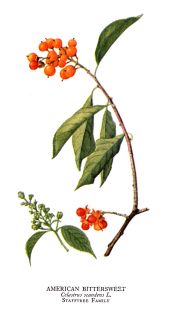The Bittersweet Season
By Audrey Stallsmith

Bittersweet, like berries that fluoresce orange
While hunters stalk through a tentative snow;
A jug spits foam; a spigot drips, and the last
Liquid life drains ruddy from the paling year.
from "Cider" by Audrey Stallsmith
Its yellow, orange, and red coloring makes celastrus scandens an ideal plant to represent flaming October. But a bittersweet fact about American bittersweet is that it's being gradually crowded out by an Asian interloper, Celastrus orbiculatus.
Of course Europeans wouldn't admit that the plant we call by that name is bittersweet at all, since they attach the title to an entirely different species--Solanum dulcamara or woody nightshade. But we'll skip the solanum this time around and concentrate on the two types of celastrus.
Celastrus derives from the Greek for "evergreen," while scandens means "climbing," and orbiculatus "disc-shaped," probably in reference to that type's rounder leaves. When they are flowering or fruiting, it's fairly easy to tell the two varieties of celastrus apart. Scandens displays its flowers and berries only in clusters at the tips of the vines. Orbiculatus, on the other hand, can produce in the leaf axils all along those vines as well.
In both cases the flowers, which appear in spring, are small, scentless, and greenish.
The much more impressive fruits are yellow or orange capsules that split open in the fall to reveal orange or red arils. The American celastrus tends to run more towards orange than the oriental type, which leans towards yellow and red. Sprays of both types are often gathered for use in autumn wreathes, bouquets, etc.
Although the berries are loved by birds, they are supposed to be somewhat toxic to humans. As the bark of bittersweet has sometimes been employed as a survival food, however, I doubt the plant can be entirely poisonous. In fact, Native Americans once used it to break fevers, which probably explains the nickname "fevertwig."
It reportedly improves absorption of nutrients from foods, helps prevent bedwetting, has anti-tumor effects and reduces the pain of childbirth. Bittersweet is also listed as an emetic, however--something that will make you throw up! So I would avoid any internal use of it.
The plant has also been known as staff vine, Jacob's ladder, and Roxbury Wax-Work (Roxbury being one of the first towns established in the Massachusetts Bay Colony). And, given its penchant for "hugging" and occasionally strangling other plants, some have even called bittersweet a "hangman for trees."
Orbiculatus, being more aggressive, is more likely to kill those trees. So, if you want a celastrus for its decorative value, please go with scandens, and provide a fence or trellis for it to grow on. That way you can have fall color from trees and vines both!
After all, as I mentioned earlier, bittersweet is an apt adjective for the autumn season. Blazingly colorful, but also presaging the arrival of a long, cold and colorless winter.
Celastrus scandens image is by the National Geographic Society, courtesy of the Southwest School of Botanical Medicine.








